

![]()
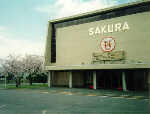 Free movies shown M-W, 7 PM; Fri., 7 and 9 PM; Sat.,
4, 7 and 10 PM; and Sun., 3 and 7 PM. Closed Thursdays. Ph# 253-5291
Free movies shown M-W, 7 PM; Fri., 7 and 9 PM; Sat.,
4, 7 and 10 PM; and Sun., 3 and 7 PM. Closed Thursdays. Ph# 253-5291
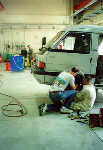 AUTO HOBBY SHOP: The relatively new Northside location is located around the block from the Northside 7-Day store. For a small fee, you can use the 8 work bays ($2), 2 hydraulic lifts ($5) and 2 pits ($3) to work on your vehicle. Or use their equipment to wash and detail your car :-) The hobby shop has the tools, and they will help the mechanically-challenged. This is a do-it-yourself facility, though... they can't do the work for you, but will help you help yourself. They even have one-on-one classes available for free! Hours: M-Th, 1pm-8pm; Fri, 1pm-9pm; Sat, 9am-8pm; Sun and Holidays, 9am-5pm. Ph# 253-4094
AUTO HOBBY SHOP: The relatively new Northside location is located around the block from the Northside 7-Day store. For a small fee, you can use the 8 work bays ($2), 2 hydraulic lifts ($5) and 2 pits ($3) to work on your vehicle. Or use their equipment to wash and detail your car :-) The hobby shop has the tools, and they will help the mechanically-challenged. This is a do-it-yourself facility, though... they can't do the work for you, but will help you help yourself. They even have one-on-one classes available for free! Hours: M-Th, 1pm-8pm; Fri, 1pm-9pm; Sat, 9am-8pm; Sun and Holidays, 9am-5pm. Ph# 253-4094
 Links to other sites on the Web
Links to other sites on the Web
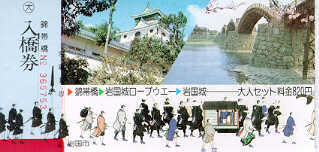
 Besides the museum in the castle, there are at least two other museums in the area, which I know of; one is an art museum, and the other is a historical museum. It's a lovely, restful area for a picnic or just a stroll or a bike ride! There are fountains and grassy areas, and several easy paths to explore. Nearby is Momijidani Park, where the walking trail up to the castle begins. This area also has several shrines and temples- we once sat in on a ceremony, and were made to feel very welcome!
Besides the museum in the castle, there are at least two other museums in the area, which I know of; one is an art museum, and the other is a historical museum. It's a lovely, restful area for a picnic or just a stroll or a bike ride! There are fountains and grassy areas, and several easy paths to explore. Nearby is Momijidani Park, where the walking trail up to the castle begins. This area also has several shrines and temples- we once sat in on a ceremony, and were made to feel very welcome!

The Akiyoshidai Area: First, to clear up some confusion you may have (I know I did)... The Akiyoshi Plateau and Cave, and the Akiyoshi-dai Plateau and the Akiyoshi-do Cave all refer to the same basic area, within Yamaguchi Prefecture. The cave is a designated Special Natural Monument, and the plateau is a Quasi-National Park. The cave was named by the Showa Emperor, on a visit in 1926, when he was still the Crown Prince. It is said to be the largest cave in Asia. The plateau area was formed during the Paleozoic era, as a coral reef in the ocean; it was carried to the "continent" by tectonic plate movement. The limestone has also been affected by igneous activity, which formed crystalline limestone about 70 million years ago! There are fossils in the rock, of coral life as well as later vertebrates such as the Japanese rhinoceros. There are also indigenous species currently living here, such as the Japanese Greater Horseshoe Bat, Japanese Great-tit (bird)and the Akiyoshi thistle (flower).
Akiyoshi Plateau: I really enjoyed this area, mostly because it's SO different from anything else I've seen in Japan. One thing I miss most about the USA is the variety... the Florida Everglades don't look anything like the Rocky Mountains, which don't look anything like the Great Plains, which look nothing like the Pacific Northwest, etc. But, most of what I've seen in Japan, looks pretty much the same. The karst plateau here is a refreshing change of pace! A little stark, it is full of it's own special beauty.
Akiyoshi Cave: The cave here is one of the largest in the world! There's no bending while touring this one!!! The walkways are man-made; the lighting could be better, but it's adequate. There are 2 major entrances to the cave, we entered the "back way", and exited from the main entrance! The most amazing and beautiful part of the cave to me, was the main cave entrance area. It is the most beautiful sight I have seen while in Japan, and ranks up there with the most beautiful places I've seen in my whole life! Pictures, while beautiful, can't do it justice; they don't capture the sounds and smells and serene feel of the woods, moss, water flowing out of the cave and through the narrow canyon. I wanted to spend longer there, just soaking it all in, but we didn't have time... we'll have to go back :-)
HIROSHIMA:
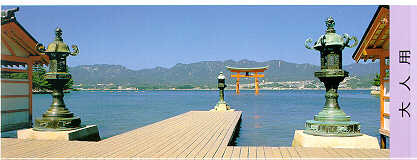
The first thing you'll notice about this island is the deer! They're everywhere! They are not afraid of humans, and in fact can be quite aggressive if you have food. They, like goats, also eat paper... I lost my maps (twice) to these hungry critters! There are also MANY shops and restaurants; prices get lower as you get further from the ferry landing. We wandered through the streets (and the people and deer) toward the famous shrine & torii;
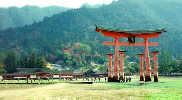 it was a very low tide when we got there, and our first sight of the torii was across a muddy tidal flat, filled with clam diggers (and the ever-present deer). It is an awesome sight, and because of the low tide, we were able to walk out to it, stand under it, touch it... up close and personal! We were interested to notice that the posts seem to be made out of huge whole tree trunks. From the Torii, we went up to the Five-Storied Buddhist Pagoda, which is also the brilliant orange-red color of the Shrine & Torii. It was especially picturesque with the autumn foliage all around. We had some lunch at a restaurant that looked good (it was), then back to sightseeing...
it was a very low tide when we got there, and our first sight of the torii was across a muddy tidal flat, filled with clam diggers (and the ever-present deer). It is an awesome sight, and because of the low tide, we were able to walk out to it, stand under it, touch it... up close and personal! We were interested to notice that the posts seem to be made out of huge whole tree trunks. From the Torii, we went up to the Five-Storied Buddhist Pagoda, which is also the brilliant orange-red color of the Shrine & Torii. It was especially picturesque with the autumn foliage all around. We had some lunch at a restaurant that looked good (it was), then back to sightseeing...
At this point we drove over to the beach. It was very odd to see this stretch of beach, ocean on one side, pine forest on the other, and deer wandering freely on the sand! Looks like a great beach, and there is a lovely park, with camping available, right there. From the beach, we drove back to the Itsukushima Shrine, originally built in 593!
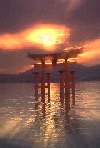 This place is an intricate complex of corridors and shrines, built on stilts over the water. The main shrine looks out across the bay to the huge 16 meter Torii. The tide had started to come in by this time, so the base of the Torii was surrounded by water. It was easy to see why this is considered one of the three most scenic places in Japan!
This place is an intricate complex of corridors and shrines, built on stilts over the water. The main shrine looks out across the bay to the huge 16 meter Torii. The tide had started to come in by this time, so the base of the Torii was surrounded by water. It was easy to see why this is considered one of the three most scenic places in Japan!
There's still a LOT to see, which we missed this time, but we'll definetely be back. They say the best times to come are spring and fall (personally, I think fall is the best). We want to hike around some of the scenic trails. We did get the chance recently to take the ropeway to the top of Mt. Misen, where the monkeys are (didn't see any monkeys, though). I've heard they are even more aggressive than the deer, but I'd still like to see them. We also took the time to visit the Miyajima Public Aquarium. By American standards (i.e., compared to Sea World) it's pretty cheesy. The Osaka Aquarium was a LOT better! But, it was something different for a change and we did enjoy our visit. Be forewarned that there is little explained in English :-(
 We had a great lunch, in a
second story restaurant, overlooking the carp-filled river running through
the center of town. The carp, which can live 60 years or more, were originally
introduced into Tsuwano's streams and storm sewers in feudal times, to
provide a source of food in case of siege. Today, the carp are very
numerous, and are a part of the charm of the town. You can even buy carp
food, and feed them when they swim up to you at the rivers edge!
The horseback archery was very interesting to watch. The riders wore
traditional costumes, including what looks like chaps, made of deerskin.
They rode along a straight course, which had three targets set up along one
side (the crowd was standing on the other side). They attempted to hit all
three targets, from the back of their galloping horse! There are supposedly
only 80 or so people in Japan still practicing this 1200 year old art.
We had a great lunch, in a
second story restaurant, overlooking the carp-filled river running through
the center of town. The carp, which can live 60 years or more, were originally
introduced into Tsuwano's streams and storm sewers in feudal times, to
provide a source of food in case of siege. Today, the carp are very
numerous, and are a part of the charm of the town. You can even buy carp
food, and feed them when they swim up to you at the rivers edge!
The horseback archery was very interesting to watch. The riders wore
traditional costumes, including what looks like chaps, made of deerskin.
They rode along a straight course, which had three targets set up along one
side (the crowd was standing on the other side). They attempted to hit all
three targets, from the back of their galloping horse! There are supposedly
only 80 or so people in Japan still practicing this 1200 year old art.
On our second visit, we rode an ITT bus to Ogari Station, where we boarded the The Yamaguchi Steam Locomotive, which took us on a scenic ride through the center of the prefecture and into Tsuwano! We used our free time to visit the Inari Shrine, and take the ropeway (this one is more like a ski lift!) to the top of the mountain to see the castle ruins, and the great view. We also had lunch in the same great restaurant, and took time to feed the carp in the river, again.
Next visit, we again saw the Yabusame exhibition, and then took a little time to explore a little of the city's Christian history. It was really a facinating story! There is a Catholic church in town, which is supposedly the only one in Japan (or the world?) with tatami mats on the floor (no pews). There is also a Chapel built to honor the Japanese Christian martyrs, which is an inspiring story. On May 3 of each year there is a procession through town, in honor of the martyrs, which draws thousands of faithful Catholics to the area.
 Next time we go, if there is a next time, we'll know to take PLENTY of yen (an entire payday's worth would probably not be too much!). The tour package included transportation (a 5-6 hour bus ride, each way), admission to the
Osaka Aquarium
(incredible set-up; we could have used more than the 3 hours allowed, to really see everything!), rooms at the
Hotel Pearl City Kobe
(double occupancy, twin beds, western-style), and breakfast buffet. Given the prices these things cost by themselves, the package was a great deal! But there was still plenty to spend money on... lunches and dinners on both days, transportation to sightseeing spots during free time, amusements and souvenirs, for instance.
Next time we go, if there is a next time, we'll know to take PLENTY of yen (an entire payday's worth would probably not be too much!). The tour package included transportation (a 5-6 hour bus ride, each way), admission to the
Osaka Aquarium
(incredible set-up; we could have used more than the 3 hours allowed, to really see everything!), rooms at the
Hotel Pearl City Kobe
(double occupancy, twin beds, western-style), and breakfast buffet. Given the prices these things cost by themselves, the package was a great deal! But there was still plenty to spend money on... lunches and dinners on both days, transportation to sightseeing spots during free time, amusements and souvenirs, for instance.
The first day, we left Iwakuni at 6am, arriving at the Osaka Aquarium a little before noon. We were able to arrange to meet a couple I had known only through the Internet, and tour the aquarium together, which was fun! We were all impressed with the arrangement, which takes you on a circular tour of the Pacific Rim of Fire. As you walk along, you travel downward from the shores to the depths of the oceans. Included are a few land animals, such as squirrel monkeys and two-toed sloths! The center tank, which is the largest, includes such open ocean fish as huge whale sharks and manta rays. The Japan deeps were represented by GIANT spider crabs! My favorites, though, were the sea otters, penguins and Pacific whitesided dolphins, which were all very playful and active :-) There was a lot more to see in the vicinity of the aquarium, but after finding a belated lunch at the end of the tour, we didn't have any more time. The bus left for the hotel in Kobe at around 3pm; after check-in (and cleaning up and resting a little), we explored the area and had a delicious dinner at a nearby restaurant cafe called Tom's Garden. It did cost over Y5000, but it had great yakiniku and beef curry rice!
The second day, we used our breakfast buffet coupons, and enjoyed the hotel's fare. They offered both Japanese and western style breafast foods; most of what we tried was good. We had free time 'till 3pm, so we decided to take the monorail system, called the Portliner, into downtown Kobe and explore the city via the City Loop bus.
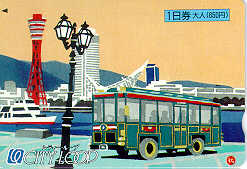 These trolley-style buses travel around to major sightseeing spots along a 13km loop; an all-day pass will allow you to get off and back on as often as you'd like. We got off in Harborland, because our Internet friends had told us there was a Sizzler's in that area. Sure enough, we found it in the Mosaic shopping and restaurant complex. Thank goodness for charge cards... the salad bar was Y1700/each, total for lunch- over Y8000!!! I really don't know how anyone can afford to live here. But it was highly enjoyable to eat familiar food, in a familiar atmosphere :-) There was also plenty of shopping in the area, though we needed to begin to make our way back to the hotel and board the bus for Iwakuni :-( It was a good trip; I wish we had had more time, and a LOT more money!!!
These trolley-style buses travel around to major sightseeing spots along a 13km loop; an all-day pass will allow you to get off and back on as often as you'd like. We got off in Harborland, because our Internet friends had told us there was a Sizzler's in that area. Sure enough, we found it in the Mosaic shopping and restaurant complex. Thank goodness for charge cards... the salad bar was Y1700/each, total for lunch- over Y8000!!! I really don't know how anyone can afford to live here. But it was highly enjoyable to eat familiar food, in a familiar atmosphere :-) There was also plenty of shopping in the area, though we needed to begin to make our way back to the hotel and board the bus for Iwakuni :-( It was a good trip; I wish we had had more time, and a LOT more money!!!
![]()
 Links to other sites on the Web
Links to other sites on the Web
 Mountains, Valleys and Waterfalls Many beautiful places to visit, in and around Hiroshima Prefecture... includes several we are familiar with as well as many we never heard about. Great for day-hike enthusiasts!
Mountains, Valleys and Waterfalls Many beautiful places to visit, in and around Hiroshima Prefecture... includes several we are familiar with as well as many we never heard about. Great for day-hike enthusiasts!
 Iwakuni White Snake HHH Hash House Harrier Group
Iwakuni White Snake HHH Hash House Harrier Group
 Roughstuff's Guide Bicycle the back streets of Iwakuni :-)
Roughstuff's Guide Bicycle the back streets of Iwakuni :-)
 KOA Kampgrounds in Japan Two Kampgrounds are near Iwakuni... grab your tent and go! You can even rent a camper on base, or stay in the cabins.
KOA Kampgrounds in Japan Two Kampgrounds are near Iwakuni... grab your tent and go! You can even rent a camper on base, or stay in the cabins.
 Kure City, near Hiroshima
Kure City, near Hiroshima
 Tokyo Disneyland
Tokyo Disneyland
 Tour of Hiroshima's Peace Memorial Park
Tour of Hiroshima's Peace Memorial Park
 New Sanno Hotel, Tokyo Are you eligible?
New Sanno Hotel, Tokyo Are you eligible?
 Michiyo's Sports Page
Michiyo's Sports Page 10/8/2000 Everything you could ever want to know about sports in Japan!
![]()
© 1997-9 usmcspencers@usa.net
![]()
Miyajima and Kintai GIF's on this page by Anthony Vashro; used with permission.